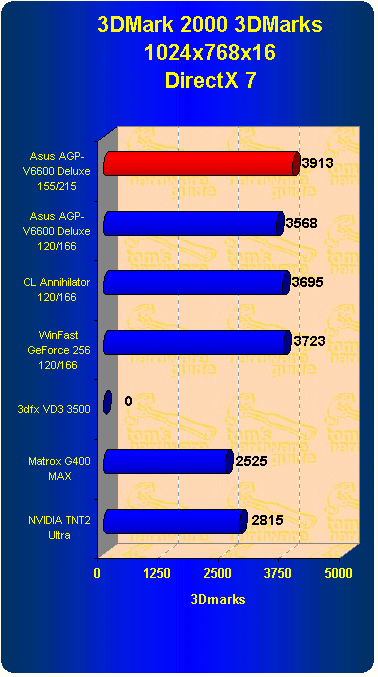Asus AGP-V6600 Deluxe Review
Benchmark Results - 3DMark 2000 (DirectX 7)
I have decided to try out Mad Onion's newly released 3DMark 2000 benchmark that uses the Max Payne game engine from Remedy/3Drealms. Normally we do not care for synthetic benchmarks but this one is based on a real application that should be out in the near future. This benchmark provides ways to gauge fill-rate, a slightly questionable T&L performance (hardware and software) test and overall 3D performance tests in various game environments. The game engine claims to have CPU optimized pipelines for Intel x87, Intel KNI, AMD Athlon and AMD 3DNow!
There are many tests available in 3DMark 2000 so I chose a few to start out with and at the resolution of 1024x768. Originally I had the data for all the resolutions we normally do but it was overkill and we do not want to miss the point of the tests by flooding you with too much information. 1024x768 is a fairly realistic resolution for the graphics solutions of today so we will look at that set of results. Please note that the 3dfx VD3 3500 would not run any of the 3DMark 2000 tests for whatever reasons. I am working to get things going for it next review. It could be drivers or it could be the benchmark for all we know.
Benchmark Results - 3DMark 2000 - 3DMarks

3DMark rating is the score derived from the performance of each card in the two graphics scenarios that 3DMark tests. The Winfast GeForce card is slightly ahead of the other two 'stock' GeForce cards but by less than a reasonable margin of error that comes into play in these tests. The two clear things here are that the GeForce cards are all on top of things as the overclocked V6600 gains about 10% performance.

Bumping the color depth up to 32-bit, the GeForce cards take a hard hit in performance thanks to the limiting SDRAM memory. However, the overclocked V6600 pulls like a mule still with its SGRAM clocked at 215 MHz.
Stay on the Cutting Edge
Join the experts who read Tom's Hardware for the inside track on enthusiast PC tech news — and have for over 25 years. We'll send breaking news and in-depth reviews of CPUs, GPUs, AI, maker hardware and more straight to your inbox.
Current page: Benchmark Results - 3DMark 2000 (DirectX 7)
Prev Page Overclocking Next Page Benchmark Results - 3DMark 2000 - Fill-Rate (single Texture)Most Popular

